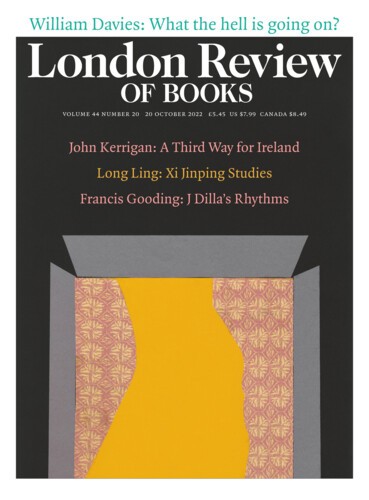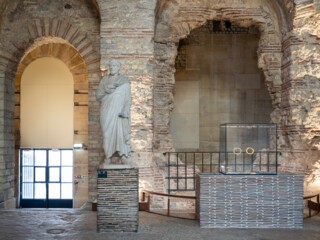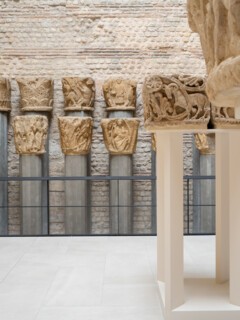The sisters of artists are doomed to bear the brunt of their brothers’ disappointments, or so Balzac’s struggling poet Lucien tells his sister, Eve, at the start of a long letter home listing his difficulties. Having come to Paris to seek love and fame he has found neither. He is broke and has had to take a furnished room in the Hôtel de Cluny, a derelict medieval house in one of the ‘dingiest roads in Paris’. The building is ‘squashed in between three churches and the old buildings of the Sorbonne’, he complains, and despite being very dirty, the room costs fifteen francs a month. Yet he doesn’t want to come home. There is something in the air that conduces to literary composition. Balzac, writing in the 1830s, put Lucien at the heart of the emerging bohemia of a decade earlier, centred in and around the former home of the Cluniac abbots on the Left Bank – the milieu of students, artists and intellectuals who championed the cause of Romanticism and medievalism against the classical canon of the academy.
Cluny has been a museum since the 1840s and since 1992 it has been the Musée National du Moyen Âge, but it still has that mystical esprit that attracted the Romantics. It contains multitudes, most famously the late 14th-century tapestry cycle of the Lady and the Unicorn, but it is the site itself, a medieval house built among the ruins of a Roman bath complex, the barely credible survival of two thousand years of use and reuse, that gives it its peculiar resonance. A speeded-up film of Cluny’s history would show it expand, contract, disappear underground, re-emerge and, after three centuries embedded (or as Balzac puts it, squashed) in the dense urban fabric of the Latin Quarter, find itself an island, only just spared by Baron Haussmann’s interventions to the east and narrowly missed on two sides by the Boulevards Saint-Michel and Saint-Germain. A palimpsest of the history of Paris and of the Roman Lutetia that came before Paris, it continues to change. In 2017 it acquired a new wing, by Bernard Desmoulin, and in May this year it reopened after a two-year refurbishment. The west front of Desmoulin’s building, its brown-gold façades in anodised aluminium, panelled and pierced to create a varying effect in changing light, give Cluny a newly confident presence, allowing it to face ‘smilingly’, as Desmoulin puts it, onto the Boulevard Saint-Michel. This for him is a positive reassertion of the museum’s place in the city and in France’s national heritage.
One of the curators, Michel Huynh, writing in the same collection of essays, published to mark the reopening, is less convinced.* Exposed now, as he puts it, like the stone of a fruit that has lost its flesh, the Roman remains are vulnerable to decay and the architecture of the medieval abbot’s house less easy to read. Perhaps, he suggests, in another few centuries it will be hemmed in again, the frigidarium will be re-covered, and Cluny will return to its true self. Perhaps. Stranger things have happened here. But Desmoulin’s brief is for this century: ‘to offer to the public those services and amenities nowadays considered the mark of a great national museum’. In other words, a visitor centre with the holy trinity of modern heritage: gift shop, lavatories and café. There is also one small new exhibition space and a new entrance, the abbots’ medieval gateway no longer considered fit for purpose. Desmoulin’s building is too big and too brassy on the outside, but Cluny has survived worse and the interior reorganisation is an impressive success. The displays are lucid and uncluttered, there is a sense of freshness without anything too obviously new. Another modern requirement, disabled access, has been achieved with imagination and without any intrusive battery of rails and ramps so that wheelchair users can now go into all the spaces, and see them in the same order as other visitors.
The order matters because Cluny has decided to revert to chronology. Its rearrangements over the years have reflected every permutation of museological theory: tableaux with figures, divisions by materials and by geography, and now what is described as a chronology with ‘thematic pauses’. It works well and the line of route flows easily from the vaulted Roman baths to the medieval abbot’s house. One pause allows visitors to see sculptures from Notre-Dame in a single space. With the cathedral still closed since the fire, the display has acquired a greater significance. Touchscreens let visitors make connections both ways between the fragments of sculpture in the museum and the façade of the cathedral. It is key to Cluny’s resilience that it has always reflected outside events and bent with the prevailing wind. After the revolution of 1789, when religious orders were abolished and their buildings aggressively secularised, Cluny was a bookstore and then an anatomy school, for which the chapel was made into a lecture theatre. When the monarchy was restored and the monuments that had been torn out of Saint-Denis were returned there, some of the other medieval art that had been exhibited in the nearby Musée des Monumens français drifted over to Cluny, adding to its attraction for the Romantic admirers of the Middle Ages.
In 1832, the antiquary Alexandre Du Sommerard moved in with his own collection of medieval art and took a couple of rooms, including the chapel. He opened his collection to the public and Cluny entered its chrysalis phase as a museum in waiting. Some of Du Sommerard’s objects are still in the collection, many more have been added and subtracted. In this latest reorganisation, artefacts dating from after 1500 have been sent to the Musée National de la Renaissance at the Château d’Écouen, north of Paris. Such drastic deaccessioning would have been disruptive for many museums, but at Cluny, where the va et vient of objects has been the norm, it has created more space and clarity for what remains. The collection is itself the product of centuries of disruption, a thing of shreds and patches, of reredoses, choir stalls and alabasters, torn from their original sites. Among the debris of 1789 are relics of other upheavals. The seventh-century votive crowns set with amethyst, pearls, jasper and jade were buried in haste near Toledo in 711 ahead of the Berber invasion of Spain and found by chance in the 1850s. Cluny offers sanctuary to many of what Alexandre Lenoir, creator of the Musée des Monumens français, called his ‘objets orphelins’.
One of the most successful redisplays of orphaned objects taken into care at Cluny is the group of 13th-century statues from the Sainte-Chapelle. The figures of the twelve apostles were removed in 1797, when the chapel was turned over to use as storage for the city’s archives, after which they seem to have disappeared from view. Four of them turned up during the 1830 revolution and were decapitated, possibly on the mistaken assumption that they represented kings of France. Later still they re-emerged and the six that were in reasonable condition were replaced on the Sainte-Chapelle while the others found their way to Cluny, home of artistic lost causes. The headless bodies no longer had their identifying attributes so it was hard to tell which head went where and they were stuck on more or less at random at the end of the 19th century. They were taken off again in 1990 when further investigation enabled them to be assigned to the right bodies, but not necessarily, it transpired, at the right angle. Saint John, who had become known as the Melancholy Saint because of his downcast gaze, has emerged from the Centre de recherche et de restauration des musées de France looking more cheerful now his face points the right way, and he and the others have been thoroughly ‘X-rayed, dismantled, studied, cleaned and reassembled’. They are displayed on a plinth through which run thin rods, attaching them invisibly to a concrete substructure. This means that the gallery has kept its springy parquet floor, but the statues don’t bounce with it. It is one of many clever improvements that have allowed Cluny to keep its character and to be reconciled with its past while meeting the demands of the present. Desmoulin has created a new internal spiral staircase which is a miracle of concision, managing to be both dramatic and sympathetic, while on the first floor, 19th-century doorways have been reopened so that the museum’s original line of route, established in the 1840s, is visible.
This uncovers another stratum in Cluny’s many-layered past. The transformation from ramshackle lodging house to museum that began with Du Sommerard’s collection continued with his publication, between 1838 and 1840, of five folio volumes illustrating it. Les Arts du Moyen Âge made the Romantic case for medieval art as the equal of classical, and the next generation carried on the campaign. The sons of Lenoir and Du Sommerard catalogued and arranged 3770 objects by type and by material, which was the way the age of international exhibitions did things. When Du Sommerard père died, the French state bought the whole site and unified it. As the Musée des Thermes et de l’Hôtel de Cluny it became the headquarters of the Service des monuments historiques, whose director, Prosper Mérimée, was fully alive to the charm of this ‘pépite’, or nugget, in the heart of Paris. Mérimée’s friend George Sand tipped him off about the Lady and the Unicorn tapestries hanging in the Château de Boussac, and he and Edmond Du Sommerard began the delicate process of acquiring them. The château belonged to the municipality of Creuse, and while it wasn’t doing much to look after the tapestries, it was reluctant to let them go. After years of tense negotiation, Du Sommerard finally acquired them in 1882.
The present campaign of renovation, the first since 1945, is not complete. This is the third of four stages and the last will see the garden of the medieval house restored and reopened. While a museum garden is in many instances merely nice to have, this one will bring the medieval site back into focus and make sense of the house. Nobody knows who began the building but Jacques d’Amboise, who became abbot in 1485, had his initials and arms carved all over it, so he must have been in charge when the big decisions were made. On the cramped triangular plot, wedged into narrow streets round the Sorbonne, an elegant and pragmatic solution emerged which became the model for a new building type. The house is built round an enclosed triangular courtyard and connected to a garden behind it. This was the first example of what became the classic Parisian hôtel particulier, ‘entre cour et jardin’, although Cluny has one remarkable extra feature. From the first-floor chapel a spiral staircase leads down into a vaulted hall running beneath it, so chapel, courtyard and hortus conclusus are linked in a vertical triangle rising from the horizontal. It’s a scene from a book of hours. When the connection is remade, Cluny will regain yet more of its esprit. After my visit I went up to Saint-Denis, where conservation is also in progress. The contrast is telling. The royal tombs that were torn out in 1793 were replaced in 1816 under the Restoration, but something vital had been lost. Their reinstallation was an attempt to rewind history and it failed. The cathedral feels hamstrung, a nerve was severed that can’t be mended, while at Cluny, where everything has been in motion for centuries, broken, repaired, realigned and re-understood, the lifeblood still flows.
Listen to Rosemary Hill discuss the Musée de Cluny, and how the idea of history developed in Britain and France in the Romantic period, in her recent series on the LRB Podcast.
Send Letters To:
The Editor
London Review of Books,
28 Little Russell Street
London, WC1A 2HN
letters@lrb.co.uk
Please include name, address, and a telephone number.



